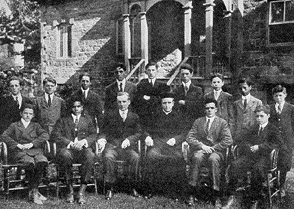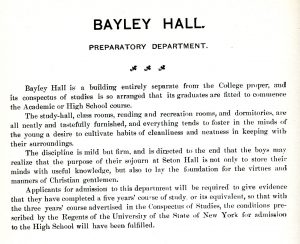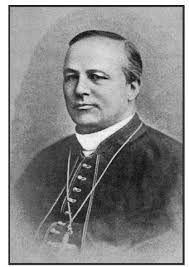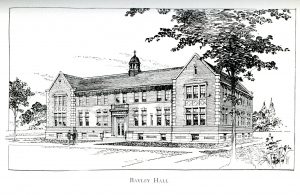Within the month of March and various commemorations honoring both Women’s History and Irish American Heritage, the Monsignor William Noé Archives & Special Collections Center houses a number of resources that represent these corresponding subject areas. In regard to specific examples, our repository also plays host to the legacy of Miss Rita M. Murphy (1912-2003), one of the most prolific figures in the annals of school history and Irish educational circles alike.
Miss Rita Murphy is one of three women born to Irish émigrés – Edward Murphy formerly of Drominarigle, Newmarket, County Cork and Mary (née Collins), a native County Longford, Éire. Rita lived most of her early life with immediate family on Wegman Parkway within the Greenville neighborhood of Jersey City, New Jersey. The Murphys were proud of their ties to Hudson County as Edward worked for several years as the Chief Clerk for the Jersey City Fire Department.
The formative academic years for Rita consisted of embracing learning opportunities offered throughout the 1910s and 20s. This included enrollment at the Sacred Heart Grammar School located in her hometown prior to her graduation from nearby St. Aloysius Academy in 1930.

Miss Murphy was a lifelong advocate of schooling for all which became one of her more serious passions upon receiving a B.S. in Education from the State Teacher’s College in Jersey City (presently known as New Jersey City University) during the early 1930s. Miss Murphy was later part of the vanguard as a member of the first class of women to enroll at the Seton Hall Urban Division in Jersey City during the Fall of 1937, and later counted among the earliest female graduates of the institution one year later. Just after receiving her diploma, Miss Murphy complimented the Urban Division personnel roster when she became the first female head of an information center on campus when named Director of the Urban Division Library during the 1938-39 academic year. Her studies at Setonia did not end here, as Miss Murphy later earned a master’s degree from the school prior by the start of the 1940 semester.
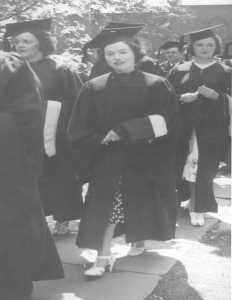
Education ultimately became a full-time vocation for Miss Murphy when she was hired as an instructor at the Sacred Heart School of Newark and then as a History Teacher at Snyder High School also located in Newark. Miss Murphy rose to the position of Department Chair during her later career after many years in a classroom setting. She was also an Assistant Professor of American History at the Seton Hall Urban Division for several semesters which complimented her work at the preparatory school level.
Miss Murphy and her legacy not only centered around the students she touched in the course of her academic life, but also as a passionate advocate and devotee of celebrating the story of Ireland, the heritage, and the people associated with her ancestral homeland.
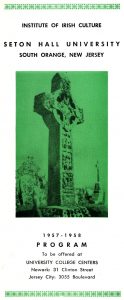
In many ways, the most memorable contribution to campus life and academics made by Miss Murphy came with her leadership efforts as long-time director of the Institute of Irish Culture with most classes held at the Jersey City and Newark campuses from the 1950s through the transition to South Orange by the 1970s. This initiative offered individuals the opportunity to study for course credit, or on a non-matriculation basis depending upon the preference of the applicant. Miss Murphy herself taught the two credit – “INTRODUCTION TO HISTORY OF IRELAND” course on Tuesday evenings during the school year. She also gave a number of independent talks and lectures around New Jersey especially during the month of March for all age groups on a number of specific topics related to Irish History and Culture. This included a specialization in folktales including her own creation entitled “The Lonely Leprechaun” among other popular themes that made Miss Murphy a widely sought speaker around the state.

Miss Murphy also hosted a long-time weekly Irish Music Program on W-S-O-U FM entitled – “Pageant of Ireland” that was christened on St. Patrick’s Day 1957 at the request of Msgr. John L. McNulty, University President. Drawing upon the popularity of this single show, Miss Murphy created a weekly 25-minute program that regularly aired on Monday evenings from 7:05-7:25 p.m. between 1957 until its final sign-off in 1994 having accounted for over 1,100 individual shows in the process. When discussing the longevity of the show with local writer, Mr. Jim Lowney during the early 1980s, Miss Murphy noted that: “When I first dedicated to do the weekly shows. I feared I would run out of themes and songs. I didn’t. Overall all those years (almost 22) every program was new and different. I found that one program idea often led to another . . .”
When it came to other areas of mass media, Miss Murphy wrote occasional newspaper articles, reports, and was enlisted for book reviews in regard to a number of Irish texts. She was also a pioneer in broadcast television when she served as a regular panelist on the “Ireland’s Heritage” television program airing over Newark-based station W-A-A-T (later W-N-E-T) TV, Channel 13 between 1955-57.
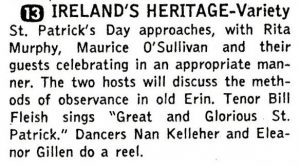


Her work continued to impact on a number of individuals moving into the following decade as Miss Murphy earned the Pro Ecclesia et Pontifice award from Pope Paul VI in 1968 for recognition of her work on behalf of the Archdiocese of Newark for her work on behalf of religious education connected with the Confraternity of Christian Doctrine within the Archdiocese of Newark.
During her lifetime, Miss Murphy divided time between homes in Jersey City and Allenhurst. It was in Allenhurst where she kept most of her personal library of books and record albums which encompassed significant square footage across three floors of the house. These resources were a constant companion both in her active years and during her retirement as the new millennium approached. Miss Murphy passed away in West Long Branch, New Jersey in 2003 and is buried at Mount Calvary in Neptune. However, her personal motto lives on: “The day you cease to burn with love, people will die with the cold.”

Seton Hall is the beneficiary of the largesse provided by Miss Murphy and various family members prior to her death with the donation of the papers, book and record albums that represents her various research and teaching aids for over half a century. Her collection of nearly 1,000 book titles is complimented by a collection of record albums and subject files including biographical data and early-mid 20th century Irish press pieces including pamphlets, clippings, letters, and other print matter with a particular emphasis on the Irish Institute, Eamon De Valera, Consulate General of Ireland, Friends of Irish Freedom, Society of the Friendly Sons of St. Patrick, Book Reviews, and other relevant materials.
This collection has since been organized into one of our signature assemblages on Ireland and the Irish Diaspora. The following abstract provides an introduction to the “Rita Murphy Papers and Phonographs Collections” (MSS 0015) which dates from 1898-2001. “Scope and Contents – The Rita Murphy papers documents her interest in Irish culture and history. There are two series within this collection; series I consists primarily of letters, newspaper clippings, and book reviews and information, series II consist of phonographic records. In series I, the letters document communication between Ms. Murphy and various Irish people of importance and the newspaper clippings document Irish cultural history. In series II, the phonographic record holdings (1908-73) include folk and classical Irish music selections along with popular Western music and spoken word recordings.”
Here is a link to find out more specific details about the Rita Murphy Collection – https://archivesspace-library.shu.edu/repositories/2/resources/183
For more information about Rita Murphy, Seton Hall University History, and any aspect of the Irish experience and/or related topics please feel free to contact us via e-mail at: archives@shu.edu or by phone at: (973) 275-2378.

